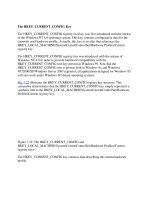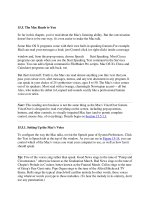Tài liệu The OFDM Advantage pptx
Bạn đang xem bản rút gọn của tài liệu. Xem và tải ngay bản đầy đủ của tài liệu tại đây (32.81 KB, 3 trang )
white paper
The OFDM Advantage
ADC's Homeworx™ cable telephony system permits the
delivery of broadband services to end customers over a
hybrid fiber coax (HFC) cable plant. Only a limited amount
of spectrum is available in which to deliver a full portfolio
of services. The greater the number of services that can be
delivered within that bandwidth, the greater the revenue
that can be generated. Thus a service provider should seek
to make optimal use of his revenue-generating
commodity that is the most scarce, bandwidth. The
spectrum modulation scheme that is implemented by the
Homeworx platform makes the most efficient use of
bandwidth of any system on the market today. In addition,
the Homeworx platform provides superior immunity to the
type of interference that is most frequently seen in the
hostile upstream path of an HFC plant.
HFC transport systems typically divide, or multiplex, the signal by either frequency or time to permit
simultaneous transmission of multiple signals. The Homeworx system uses a form of frequency
division multiplexing — orthogonal frequency division multiplexing, or OFDM — to efficiently
permit the transmission of many signals. The Homeworx system also uses 32-level quadrature
amplitude modulation, or QAM-32, to pack the maximum number of signals into a given quantity
of bandwidth. Many competing HFC systems use a combination of time division multiplexing (TDM)
and quadrature phase shift keying (QPSK) to accomplish the same purpose. The combination of
OFDM and QAM-32 makes more efficient use of bandwidth and is more resistant to interferers than
its TDM/QPSK competitor.
In addition, the Homeworx system is the only HFC
telephony system with variable modulation order. This is
called DC-OFDM (dual constellation OFDM). The system
can switch from QAM-32 to QAM-4 while maintaining
the same orthogonal multiplexing. This provides either a
2.5x bandwidth increase (QAM-32) or a 10dB SNR
advantage (QAM-4) depending on the application.
Though many commonly transmitted signals are fundamentally analog, or time-continuous in
nature, a signal can also be represented in its discrete, or digital, form for the highest degree of noise
immunity. Therefore, many transmission systems utilize digital modulation techniques. One digital
modulation technique, quadrature amplitude modulation, takes advantage of the following
mathematical property: separate input signals may be carried on different components of a single
frequency carrier wave, and successfully resolved into the original inputs by the receiver. One version
The spectrum modulation
scheme that is implemented by
the Homeworx platform makes
the most efficient use of
bandwidth of any system on
the market today. In addition,
the Homeworx platform
provides superior immunity to
the type of interference that is
most frequently seen in the
hostile upstream path of an
HFC plant.
The Homeworx system is the
only HFC telephony system with
variable modulation order, called
DC-OFDM (dual constellation
OFDM).
of quadrature amplitude modulation (QAM) uses
binary-level modulation of the single frequency
carrier wave components, generating an output
signal space, or constellation, with four message
points. Each of these message points, or symbols,
carries two bits of information. (Please see Figure l).
This is known as QAM-4, or QPSK. By using two
components of the carrier wave, QPSK is able to
carry twice as much information in the same
amount of bandwidth.
Higher-level QAM is able to optimize bandwidth
even further by modulating the carrier frequency to
a higher number of discrete levels. For example,
32-level QAM, used by ADC, generates a signal
space, or constellation, with 32 discrete symbols.
(Please see Figure 2.) Instead of using binary-level
modulation, QAM-32 employs modulation that uses
six discrete levels of the frequency carrier wave
components. Each symbol in QAM-32 carries five
bits of information. While both QAM-4 and QAM-
32 improve bandwidth efficiency, the improvement
that comes with QAM-32 is much more significant.
Each of the competing modulation schemes must
also implement a method of simultaneously
transmitting these compressed digitized signals
without interference. Time division multiplexing, or
time division multiple access (TDM or TDMA)
transmits many signals in a common 2 MHz of
spectrum. The signals are transmitted alternately in
time, so that the signals take turns occupying the full
2 MHz of spectrum but no one signal requires its
own full 2 MHz channel. Approximately 24-32
different signals, or DS0s, typically share one 2 MHz
channel. In frequency division multiplexing, or
frequency division multiple access (FDM or FDMA),
signals are modulated on varying carrier frequencies
so that they can be transmitted at the same time.
ADC's version of FDMA, orthogonal frequency
division multiple access, or OFDMA, divides each DS0
payload byte into two parts, each of which are
carried on a different tone (frequency) in the RF
channel. 480 tones are carried in each 6MHz
channel, or 240 DS0s. ADC's OFDM/QAM solution is
capable of delivering 240 DS0s in each 6 MHz
channel, a clear advantage compared to the 72-96
DS0s per 6 MHz channel delivered by TDM/QPSK
systems. Furthermore, the OFDM modulation
scheme more effectively combats the type of
interference most frequently encountered in the
upstream path of an HFC system.
Figure 2. QAM-32 Constellation
Figure 1. QPSK Constellation
ADC's OFDM/QAM solution is
capable of delivering 240 DS0s
in each 6 MHz channel, a clear
advantage compared to the
72-96 DS0s per 6 MHz channel
delivered by TDM/QPSK systems.
Analysis of the upstream channel of an HFC plant will show that the type of interference most
commonly encountered is narrowband interference. Several different types of amateur- and citizen-
band radio are allotted narrow slots of frequency that fall within the 5-42 MHz band that is used for
upstream transmission. In addition, some household appliances also emit RF output in this frequency
band. These signals appear in the HFC plant as narrowband interferers that could potentially be severe.
In a TDMA system, a narrowband interferer that falls anywhere within the 2 MHz bandwidth carrying
the 32 upstream signals may render the entire 2 MHz useless for transmission. In an OFDMA system,
each tone occupies only a very narrow slice of spectrum. A narrowband interferer may disrupt a few
tones, but the amount of bandwidth loss incurred by the presence of an interferer is minimized.
Additionally, ADC's modulation scheme implements dynamic frequency allocation. In the event of an
interferer, the Homeworx system can assign a DS0 to a new portion of the spectrum without dropping
the connection. Note that no “special” 2 MHz bands must
be assigned for frequency hopping, unlike TDMA systems
which further waste the bandwidth of an already
inefficient system. Thus, ADC's Homeworx OFDMA HFC
system provides protection against narrowband interferers
that is superior to that of TDMA competitors.
Impulse noise is another type of interference that may be
encountered in the upstream path of an HFC system. An
impulse noise is very short in time, but occupies a wider
bandwidth. Impulse noise may be caused by time varying discontinuities in the cable plant or ingress
from motors or high power arcing. Since frequency-multiplexed signals are not divided in time, they
have substantially longer symbol periods than time-multiplexed signals. In the case of low-level impulse
noise, power is distributed throughout the entire spectrum; therefore, its effect on any single DS0 is
greatly reduced in FDMA systems. The Homeworx system implements additional protection by the use
of block error correction algorithms to compensate for bit errors resulting from high level impulse
noise. No competing telephony system utilizes error correction, the most effective guard against
impulse noise. ADC's system is more effective at combating impulse noise than TDMA systems by
providing superior resistance to low-level impulse noise and by providing additional compensation for
high level impulse noise.
The broadband service delivery marketplace is likely to be a competitive one. Having the ability to
deliver the highest quality of service while maximizing resources supports a favorable business
equation for the service provider. The OFDMA/QAM-32 solution employed by the ADC Homeworx
system delivers the most services in the least amount of bandwidth, providing unsurpassed spectral
efficiency. Furthermore, the Homeworx system provides protection against interference that is far
superior to that of any other platform on the market today.
3
ADC Telecommunications, Inc., P.O. Box 1101, Minneapolis, Minnesota USA 55440-1101
Specifications published here are current as of the date of publication of this document. Because we are continuously improving our
products, ADC reserves the right to change specifications without prior notice. At any time, you may verify product specifications by
contacting our headquarters office in Minneapolis. ADC Telecommunications, Inc. views its patent portfolio as an important corporate
asset and vigorously enforces its patents. Products or features contained herein may be covered by one or more U.S. or foreign patents.
100084EC 03/01 Original © 2001 ADC Telecommunications, Inc. All Rights Reserved An Equal Opportunity Employer
Web Site: www.adc.com
From North America, Call Toll Free: 1-800-366-3891 • Outside of North America: +1-952-938-8080 Fax: +1-952-946-3292
For a complete listing of ADC's global sales office locations, please refer to our web site.
ADC's Homeworx system is
more effective against both
narrowband interference and
impulse noise than systems
relying on TDMA.









